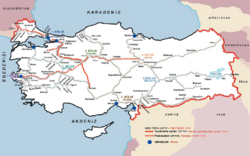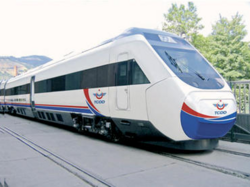Turkish State Railways
Turkish Republic State Railways (TCDD, Türkiye Cumhuriyeti Devlet Demiryolları) is the state corporation that operates the public railway system in Turkey. The organization was founded in 1927 to take over the operation of railways that were left within the borders of the Turkish Republic after the dissolution of Ottoman Empire, which up until then had been run and financed by private corporations.
Today the TCDD operates over 8500 kilometres of railway lines.
Contents
International connections
Passenger trains
Direction Europe
- The Bosfor Express (Istanbul - Bucharest)
- The Balkan Express (Bucharest - Budapest)
- The Prietenia Express (Bucharest - Chişinău)
- The Balkan Express (Sofia - Beograd)
- IC 90/91 (Pythion - Thessaloniki)1
TCDD is member of Inter Rail and is listed in zone G with Greece, Italy and Slovenia
1 An agreement has been signed between TCDD and OSE (ΟΣΕ), the Greek Train Administration Company between the 14th and 15th June 2005 which will allow the direct movement of a Train to Thessaloniki from Istanbul and vice-versa. It is planned to set up a train until 15 July 2005.
Direction Middle-East
- The Trans Asia Train (Istanbul - Tehran)
- Van - Tabriz
- with The Toros Express (Istanbul - Gaziantep - Syria)
- Gaziantep - Baghdad (Currently not working)
Projects Under Construction
Marmaray Project
- For more details on this topic, see Marmaray.
This Project is a shared rail underground tunnel system which will connect the rail lines in the European and Asian sides of Istanbul under the strait of Istanbul, Bosporus which actually connects the European rail networks to the Middle Eastern and Asian rail networks. In addition to this, the tunnel is also projected to form an east-west rail system line for the massively populated Istanbul metropolitan area and decrease the public transportation problem while increasing the percentage of the use of rail systems in public transportation from 3,6% to 27,7% putting Istanbul third in the world ranking after Tokyo (60%) and New York (31%).
High-Speed Rail Projects
Istanbul - Ankara High-Speed Track
The Railway will lead from Ankara via Eskişehir to Istanbul. With this project a trip from Istanbul to Ankara will take about 3 hours and 10 minutes at the maximum speed of 250 km/h. The trains will consist of the Spanish CAF trains.
Ankara - Konya High-Speed Track
The new railway, that will dramatically shorten the travel time between Ankara and Konya to 70 minutes, will connect to the Istanbul-Ankara Line in Polatli. The same set of CAF trains will be used on this line.
Further High-Speed Rail Projects
- Ankara - Afyon - Uşak - İzmir line (joining to the Istanbul - Ankara line in Polatlı)
- Ankara - Yozgat - Sivas line
- Istanbul-Bursa / Ankara - Bursa line (joining to the Istanbul - Ankara line in Osmaneli)
- İstanbul - Kapıkule line (directing Sofia at Bulgarian border)
- For more details on this topic, see High-speed rail in Turkey.
History
Ottoman railways
The history of Turkish Railways dates back to 1856. The first railway line in Turkey was the 130 km İzmir - Aydın line, on which a British Company was appointed. The choice of this particular spot was not random. The İzmir - Aydın track was built because of its high commercial potential. Another reason was that this particular area had raw materials that were necessary for British industry. Also this area was important for controlling the Middle East, and at that time of the Ottoman Empire after the English were given the first license, France and Germany began to build up different areas where they exercised their power. Those countries tried to deliver the goods that were necessary for their industries, that they bought from the Ottoman Empire, as fast as possible to the seaports. The railways were built to be as efficient as possible, and were strategically placed, for example being within around 20 km of mines, etc. So the railways were actually placed according to the politics of those foreign countries.
Between the years 1856 - 1922 the following tracks were built in the realm of the Ottoman Empire:
- Rumeli Railways 2383 km normal track
- Anatolia - Baghdad Railways 2424 km normal track, (Baghdad Railway)
- İzmir - Kasaba and its extensions 695 km normal track
- İzmir - Aydın and its branches 610 km normal track
- Damascus - Hama and its extensions 498 km narrow ve normal track
- Jaffa - Jerusalem 86 km normal track
- Bursa - Mudanya 42 km narrow track
- Ankara - Yahşihan 80 km narrow track
- Damascus - Medina 1300 km narrow track, (Hejaz railway)
Total 9,919 km
In this case after the Republic was declared in Turkey, only 4000 km of the railway tracks that were built by foreign companies were left within the national borders. To be more precise, the young Turkish Republic inherited from the Ottoman Empire 2,282 km normal tracks and 70 km narrow tracks owned by foreign companies and 1,378 km normal tracks owned and operated by the former Ottoman Empire.
After the Republic
1923 - 1950: The railway period
Before the Republic was announced the railway tracks were build for the benefit of the foreign countries, but after the formation of the Republic in Turkey the railway tracks were built for the good of the Republic. This can be clearly seen of the industralization plans released between 1932 and 1936 which were based on iron and coal etc. The cheapest and most efficient way to transport those goods was to build railways. In those years the financial assets of transportation were transferred to railways.
In those years of shortage, the construction of railways continued on high-speed. During the Second World War the constructions slowed down. 3,578 km of the tracks that were build between 1923 and 1950, 3,208 km were completed before 1940.
At those times the railways were included in the National Economy procedures. The aim of constructing railways were stated as:
- To connect potential production centers with the natural resources.
- To connect production and consumer centers especially with seaports, and fascilitate communications with rural areas.
- To connect commercially undeveloped areas, in order to speed up economic progress across the country. Through this policy 1927 Kayseri, 1930 Sivas, 1931 Malatya, 1933 Niğde, 1934 Elazığ, 1935 Diyarbakır and 1939 Erzurum were connected to the railway network.
- To enhance national security, therefore creating a comprehensive communication network within the country with railways.
To reach those targets the railway politics were lead in two stages:
- Despite the financial problems, the railways that were owned by foreign companies were bought and nationalized, a part of it was transferred with agreements.
- Since most of the railways were concentrated in the West of Turkey, the aim was to connect the central and Eastern areas with trade centres and coasts. At this period the newly built main routes were: Ankara - Kayseri - Sivas, Sivas - Erzurum (the Caucasus route), Samsun - Kalin (the Sivas route), Irmak - Filyos (the Zonguldak coal route), Adana - Fevzipaşa - Diyarbakır (the copper route), Sivas - Çetinkaya (the iron route). Before the Republic 70% of the routes were to the west of Ankara - Konya, after the Republic 78.6% were constructed in the east so that a balance of 46% to 54% was reached.
Between 1935 and 1945 the railways were joined. Those joinings created cycles in the railways which for example shortened the distance between Ankara - Diyarbakır from 1,324 km to 1,116 km.
In those times the road system was designed to aid the railways.
1950 and after: the Golden Road period
The road system that was left from the Ottoman Empire, consisted of 13,885 km ruined surface roads, and 4.450 km stabilized roads, which totaled 18,335 km and 94 bridges.
The road systems was seen until 1950 as a system to aid the railways. But instead of strengthening the rail network, the automobile roads were extended because of the Marshall plan.
After 1960 even though there were many targets that aimed at the extension of the railroads, most of the financial assets were transferred into automobile roads. Because of these politics, between the years 1950 and 1980 an average of 30 km of railroads were constructed.
In the mid 1980s in Turkey a mobilization was started to build Autobahns, the Autobahns project was the third largest project after the GAP and Tourism projects. Because of those projects, until the mid 1990's about US$2,000,000,000 were invested. In these years no investments were made to railroads, and no projects were initiated. Most of the railways (most of them more than 50 years old) were left to their own fate.
In Turkey goods are carried 94% on roads, only 4% are carried on railroads. The share of goods transportation in Turkey by trains deceased in 50 years by 60%.
Railroad construction chronology
Tracks constructed before the Republic
Still in use
| Route | Opening | Length (m) |
| İzmir-Aydın Railroad | ||
| Şirinyer - Buca | 1860 | 2,452 |
| İzmir - Sütlaç |
1861 |
356,505 |
| Torbalı - Tire | 1883 | 47,541 |
| Gaziemir - Seydiköy | 1886 | 1,088 |
| Alaşehir - Uşak | 1887 | 117,810 |
| Çatal - Ödemiş (Şehir) | 1888 | 26,452 |
| Goncalı - Denizli | 1889 | 9,430 |
| Sütlaç - Çivril | 1889 | 30,224 |
| Ortaklar - Söke | 1890 | 22,012 |
| Sütlaç - Eğirdir | 1912 | 113,795 |
| İzmir-Turgutlu Railroad | ||
| Basmane - Menemen |
1865 |
31,680 |
| Halkapınar - Bornova | 1865 | 4,878 |
| Menemen - Manisa - Turgutlu | 1865 | 61,500 |
| Turgutlu - Alaşehir | 1875 | 75,790 |
| Uşak - Afyon | 1890 | 134,946 |
| Manisa - Kırkağaç | 1890 | 80,853 |
| Kırkağaç – Bandırma | 1912 | 195,244 |
| Eastern Railroad | ||
| Sirkeci - Yenikapı |
1872 |
4,756 |
| Yenikapı - Florya | 1871 | 16,372 |
| Florya - Hadımköy | 1872 | 30,325 |
| Hadımköy - Çatalca | 1873 | 19,610 |
| Çatalca - Hudut | 1873 | 209,899 |
| Karaağaç - Hudut | 1873 | 7,137 |
| Mandıra - Kırklareli | 1912 | 45,594 |
| Anatolia Railroad | ||
| Haydarpaşa - Feneryolu |
1872 |
5,088 |
| Feneryolu - Pendik | 1872 | 21,162 |
| Pendik - Gebze | 1873 | 19,681 |
| Gebze - İzmit | 1873 | 47,096 |
| İzmit - Büyükderbent | 1890 | 18,312 |
| Büyükderbent - Mekece | 1891 | 71,709 |
| Mekece-Vezirhan | 1891 | 32,831 |
| Vezirhan - İnönü | 1892 | 65,980 |
| İnönü - Ağapınar | 1892 | 55,823 |
| Ağapınar - Yalınlı | 1892 | 54,954 |
| Yalınlı - Sazılar | 1892 | 61,902 |
| Sazılar - Beylikköprü | 1892 | 14,317 |
| Beylikköprü - Ankara | 1892 | 109,516 |
| Eskişehir - Kütahya | 1894 | 76,984 |
| Alayunt - Çöğürler | 1895 | 19,631 |
| Çöğürler - Afyon | 1895 | 74,615 |
| Afyon - Akşehir | 1895 | 98,128 |
| Akşehir - Ilgın | 1896 | 57,641 |
| Ilgın - Konya | 1896 | 116,796 |
| Arifiye - Adapazarı | 1899 | 8,491 |
| Baghdad Railroad | ||
| Konya - Bulgurlu |
1904 |
198,892 |
| Bulgurlu - Ulukışla | 1911 | 38,733 |
| Ulukışla - Durak | 1912 | 90,469 |
| Durak - Yenice | 1912 | 17,915 |
| Southern Railroad | ||
| Fevzipaşa - Meydanıekbez |
1912 |
35,411 |
| Border - Çobanköy - Nusaybin | 1917 | 382,106 |
| Derbesiye - Mardin | 1917 | 24,340 |
| Toprakkale - İskenderun | 1912 | 59,220 |
| Mersin-Tarsus-Adana Railroad | ||
| Mersin - Yenice | 1882 | 43,209 |
| Yenice - Adana (City) | 1886 | 23,949 |
| Sarıkamış-Kars-Border Railroad | ||
| Sarıkamış - Kars - Border (broad line, can be converted to normal line) |
1913 | |
| Before the Republic Main Routes | 3,714,280 | |
| Before the Republic Secondary Routes | 844,995 | |
| Before the Republic Total | 4,558,995 |
Disassembled narrow tracks
| Track | Length (m) |
| Mudanya – Bursa | 41,110 |
| Ilıca - Palamutluk | 28,391 |
| Samsun - Çarşamba | 39,465 |
| Maden - Sarıkamış | 231,940 |
| Total | 340,906 |
See also
External links
- Turkish Republic Railways Company Website
- A Short History of Turkish Railways including maps
- Turkish Republic Railways Company Workers and Retired Personnel Social Aid Foundation
- Republic of Turkey Ministry of Culture - Ankara Railway Museum
- Republic of Turkey Ministry of Transport
de:Türkiye Cumhuriyeti Devlet Demiryolları
fr:TCDD
id:Turkish State Railways
sv:TCDD
tr:Türkiye Cumhuriyeti Devlet Demiryolları



